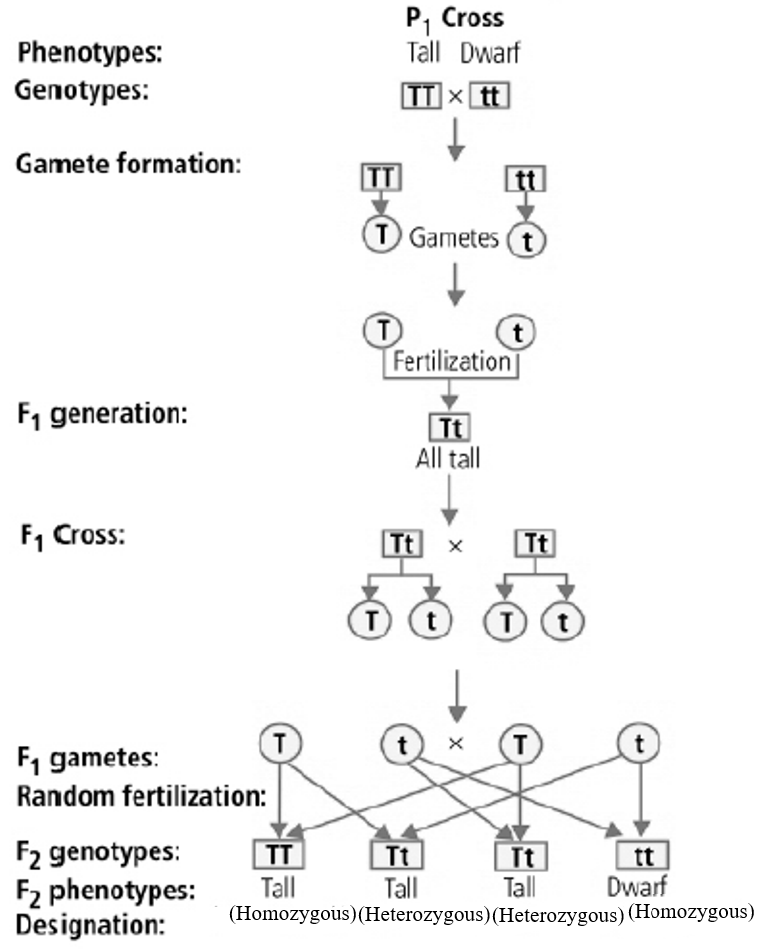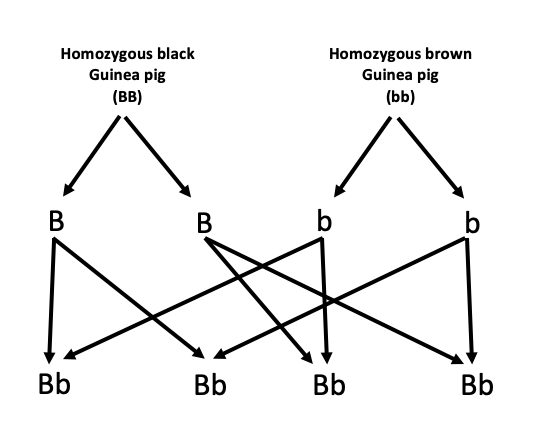Heredity and Mendelism
Subject: Science

Overview
Living things, including plants, can pass on traits to their offspring through hereditary characters. Mendel, the father of genetics, conducted an experiment on pea plants to demonstrate that inherited traits are passed down. He examined seven pairs of opposing traits in pea plants, focusing on the first filial generation. The results showed that pure tall plants were the source of tall plants, while hybrid tall plants produced tall and dwarf plants. The phenotypic and genotypic ratios were similar, with the first filial generation having only one dominant character. Mendel's rule of dominance states that when two pure people with opposing traits are crossed, only one character is expressed externally in the F1 generation. This was demonstrated in the F1 generation of hybrid black guinea pigs. The purity of gametes was also observed, with the first-generation hybrid gametes producing tall and dwarf plants. Mendel's law of independent assortment states that alleles of two or more distinct genes are sorted into gametes independently of one another.
All living things are capable of bearing progeny that resembles them. They give birth to their children in order to perpetuate their generation for this reason. Children take on the traits of their parents and grandparents. Despite having a similar appearance, the organisms differ in a few key ways. Both sexual and asexual reproduction result in the transmission of parental traits to the progeny. The genes found in the chromosomes of a cell's nucleus are responsible for passing on these features from one generation to the next. Since every gene encodes a unique trait unique to an organism, genes are the means by which the traits of a parent are passed on to their offspring. Heredity is the term used to describe the phenomenon where parental traits are passed on to their offspring, and such characters are called hereditary characters.
Born in Austria on July 22, 1822, Mendel is regarded as the father of genetics. In order to demonstrate that inherited traits are passed down from parents to their children, he conducted several tests on the pea plants in his garden. He took into consideration seven pairs of opposing traits in the pea plant throughout his studies, and they are as follows:
- Height of Plant: Tall (TT) and dwarf (tt)
- Position of Flower: Axial (AA) and terminal (aa)
- Color of Pod: Green (GG) and yellow (gg)
- Shape of Pod: Inflated (II) and constricted (ii)
- Shape of Seed: Round (RR) and wrinkled (rr)
- Color of Flower: purple (RR) and white (rr)
- Color of Seed: yellow (YY) and green (yy)
Mendel selected pea plants for his research due to the following reasons:
- Pea plants are bisexual and their flowers are closed, making them naturally self-pollinating plants.
- If necessary, cross-pollination can be carried out.
- Because of their short life cycle, they may generate offspring more quickly.
- They feature a lot of characteristics that contrast in pairs.
- Several seeds can be generated simultaneously, which leads to the production of numerous progeny.
- It's simple to grow them.
Method of Mendel Experiment
Mendel categorized each child based on the characteristic after examining seven pairs of pure and hybrid qualities that were present in pea plants independently. In order to investigate heredity, he picked pure dwarf and tall pea plants and pollinated them together. The first filial generation seeds were those that were cultivated after that pollination. The initial filial generation's plants were all tall. He also conducted tests with the remaining duos of opposing personalities. He discovered findings that were comparable, meaning that in each of the first filial generations, just one character was expressed. The dominant character is the one that emerged from the pollination of two pea plants, each of which had two opposing characteristics. This character was manifested in the first filial generation. The personality that was hidden in the first filial generation was termed recessive character.
Mendel allowed the hybrids created in the first filial generation to self-pollinate. The progeny produced in the second filial generation were tall and dwarfed following self-pollination. Of these, 25% were dwarfs and 75% were tall. Additionally, all of the offspring were pure tall pea plants, having self-pollinated the pure tall progeny of the second filial generation. Self-pollination between pure dwarf plants produced only pure dwarf offspring of the second generation. Similarly, hybrid offspring of the second filial generation that were allowed to self-pollinate produced 75% tall and 25% dwarf pea plants, as seen in the chart below:
Results of Mendel's experiment
a. Pure tall plants were the source of tall plants.
b. From hybrid tall plants, dwarf and tall plants were generated in a 3:1 ratio.
C. Pure dwarf plants were the source of dwarf plants.
Phenotypic Ratio and Genotypic Ratios in Mendel's Experiment
An organism's phenotypic characteristics are those that are visible from the outside. Comparably, genotypic character refers to an organism's genetic composition or genetic makeup.
The phenotypic ratio is Tall: dwarf = 3:1
Genotypic ratio is pure tall: hybrid tall: pure dwarf = 1:2:1
Monohybrid Cross and Dihybrid Cross
A monohybrid cross is created when two pure plants or other organisms are crossed while taking into account two opposing traits. For instance, in the first filial generation, cross-pollination between a pure tall pea plant and a pure dwarf pea plant resulted in 100% hybrid plants.
Analogously, a dihybrid cross is created when two pure plants or other creatures are crossed while taking into account two pairs of opposing characteristics.
Laws of Mendel
- Law of Dominance
- Law of Segregation or Law of Gamete Purity
- Independent Assortment Law
Law of Dominance
Mendel's rule of dominance states that when two pure people with two opposing traits are crossed, only one character—referred to as the dominant character—expresses itself externally in the F1 generation. Therefore, in the F1 generation, the trait or character that is displayed externally is referred to as the dominant character, and the trait or character that is hidden is referred to as the recessive character.
In Mendel's experiment, all hybrid offspring in the F1 generation are outwardly tall, showing that the tall trait is dominant and the dwarf trait is recessive. Cross-pollination between pure tall and dwarf pea plants is the means of achieving this.
By crossing guinea pigs, Mendel's law of dominance may also be investigated. The F1 generation of hybrid black guinea pigs is created when white guinea pigs (BBB) and black guinea pigs (BBB) are bred. In this instance, the dominant color is black, whereas the recessive color is white.
Law of Purity of Gametes
In the first generation hybrid, two distinct characters live together, yet they maintain their individuality while being pure. You can tell the difference between the pure and hybrid allele genes in the mother cell during meiosis cell division. This makes hybrid gametes, but only pure characters enter each gamete. It indicates pure gametes were produced. We refer to this rule as the purity of gametes.
For instance, the genes of the hybrid alleles split during self-pollination among the offspring derived in the first filial generation, resulting in the production of tall and dwarf plants in the next generation. Tall plants to dwarf plants have a 3:1 ratio.
Law of Independent Assortment
The alleles of two or more distinct genes are sorted into gametes independently of one another, according to Mendel's law of independent assortment. To put it another way, a gamete's allele for one gene does not affect the allele it obtains for another.
75% of the hybrid guinea pigs born from mating pure black and pure white animals produced a similar outcome. In this instance, the genotypic ratio (pure black, hybrid black, and pure white) was 1:2:1, but the phenotypic ratio of black and white was 3:1.
Things to remember
- Mendel, born in Austria in 1822, conducted tests on pea plants to demonstrate that inherited traits are passed down from parents to their children.
- Mendel examined seven pairs of opposing traits in pea plants independently, focusing on the height of the plants, flower position, pod color, pod shape, seed shape, flower color, and seed color.
- Mendel's experiment revealed that pure tall plants were the source of tall plants, while hybrid tall plants produced tall and dwarf plants.
- Mendel's rule of dominance states that when two pure people with opposing traits are crossed, only one character is expressed externally in the F1 generation.
- The purity of gametes is another key law, as only pure characters enter each gamete during self-pollination among offspring derived in the first filial generation.
- The alleles of two or more distinct genes are sorted into gametes independently of one another, as per Mendel's law of independent assortment.
© 2021 Saralmind. All Rights Reserved.






 Login with google
Login with google